The silence of the birds: How can we make sure common songbirds stay common?
Ironically, a Zoo exhibition of common migratory songbirds may help ensure these backyard birds never become exotic rarities found only in zoos.
The reason many people visit zoos is to marvel at exotic animals from faraway places: elephants from Africa, tigers from India, pandas from China, and orangutans from Borneo and Sumatra, for example.
So, when the newly renovated Bird House at the Smithsonian’s National Zoological Park reopens late next year, visitors stepping inside may be surprised to see an array of familiar migratory songbirds, waterfowl and shorebirds from their own backyards. The exhibition has been in the works for a number of years and is designed to focus on the message that while migratory bird species of North America are in serious trouble with populations in alarming decline, we have the power to help wild birds and in the process, help ourselves.
Inside the new Bird House, visitors will learn of simple things they can do to help the birds of North America, messages that will be woven throughout the exhibit. The advice ranges from keeping your pet cats indoors [cats kill more than 1 billion birds in the United States each year], and how to make the windows of your home, apartment, and office bird-friendly [an estimated 1 billion birds die each year by crashing into reflective windows and buildings], to cutting down pesticide use, planting native plants and drinking bird-friendly coffee, explains Sara Hallager, curator of Birds at the National Zoo.
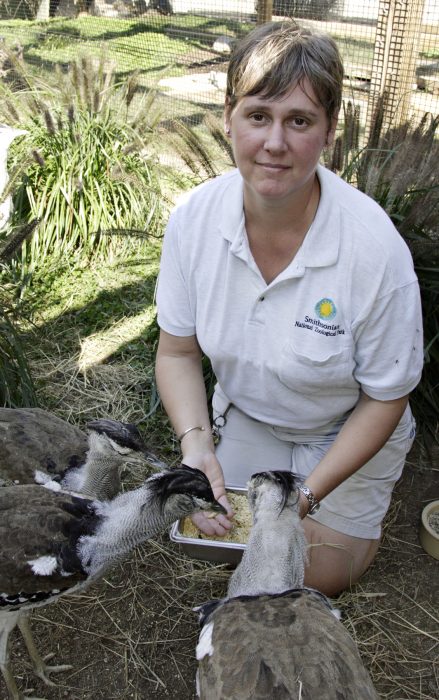
Sara Hallager and some friends at the Smithsonian’s National Zoo. (NZP photo)
Hands-on exhibits, inspiring art, walk-through aviaries, and a bird-tracking lab will immerse visitors in the phenomenon of migration and bird conservation. Ongoing citizen science activities and STEM-based curricula for teachers will encourage visitors to stay involved long after leaving the Zoo.
One major behind-the-scenes challenge to achieving this vision, Hallager says, is that this is the first time that North America’s migratory birds have been the focus of a living zoo exhibition. For birds as common as the indigo bunting, Baltimore oriole, or American robin, virtually nothing was known about how to raise and breed them under human care.
Today, Bird House staff and staff at the Zoo’s Migratory Bird Program are writing the book on raising and breeding these birds, Hallager says. “We are raising and breeding birds that no other zoos have worked with before. And it’s a big deal,” she adds. This year the National Zoo was presented with a Plume Award from the American Association of Zoos and Aquariums for their pioneering work raising and breeding North American migratory songbirds.
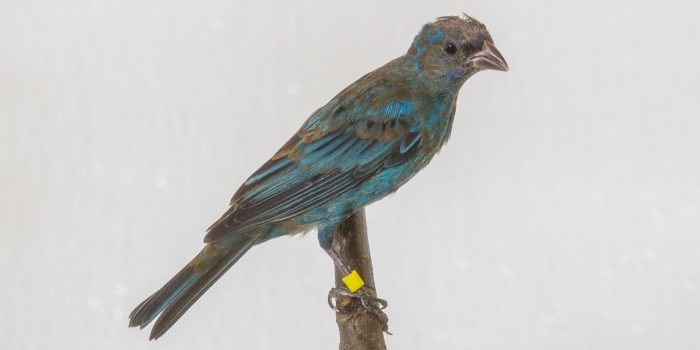
A juvenile indigo bunting (Photo by Skip Brown)
“We are developing husbandry protocols now for common birds like the indigo bunting,” Hallager says. “In 2018, Bird House staff bred indigo buntings for the first time. In 2019 we again bred indigo buntings, as well as wood thrushes and scarlet tanagers. Back in 2016, we bred Baltimore orioles. This year, we have already seen positive breeding behavior in a few other North American migratory bird species in our care. We are hopeful our breeding success with all these songbirds will continue.”
When Hallager and her team started out, there was a consensus that North American migratory songbirds could not survive in human care. “We’ve completely blown that out of the water. That is completely untrue,” Hallager says. “A second assumption was that we would never be able to breed migratory songbirds. That also is not true.”
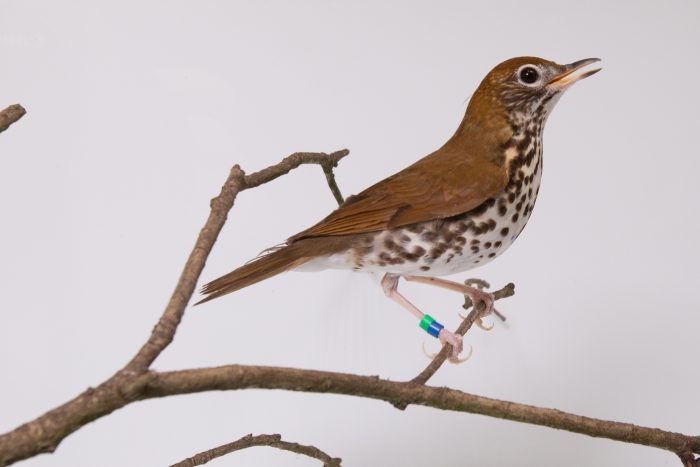
Wood thrush (Photo by Amy Enchelmeyer)
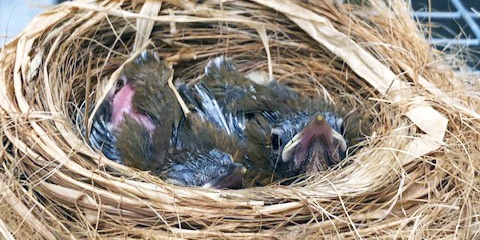
Wood thrush chicks in their nest (Photo by Kathy Brader)
Between the bird keepers, the nutritionists, and the veterinarians at the National Zoo, “we learned how to care for and breed these birds working together as a team,” Hallager says. “They just have different needs than nonmigratory songbirds. But we are learning that, and we are writing the book. Eventually we will be able to share this information with colleagues at other zoos.”
Diet is one of many aspects of raising migratory songbirds that has revealed their complex physiology, Hallager says.
In spring they fly up from Central and South America, arrive at their North American breeding grounds, having just completed an incredible journey. They sing, mate, build nests, lay eggs, raise chicks and then head south for the winter.
“To be able to migrate they go through an incredible physiological change, putting on a lot of weight. In the wild this is not a big deal, because they burn up their fat reserves during their long flight,” Hallager says.
In the Bird House, they go through this same physiological change but then they don’t take the weight off. Zoo Nutritionist Erin Kendrick must modify their diets on an almost daily basis.
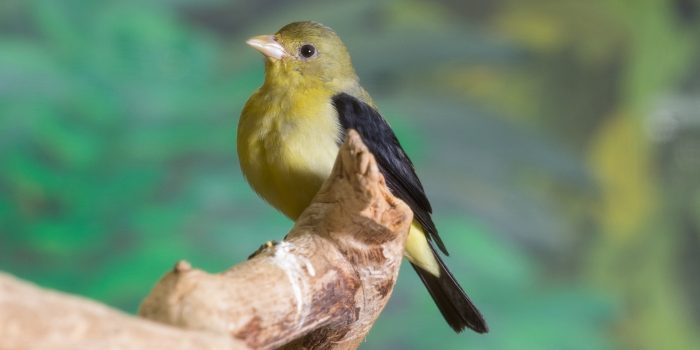
This female scarlet tanager is the mother of two chicks that hatched at the Zoo in July 2019.
“One thing we’ve learned in the past few years is that at certain times some of these birds need a lot of bugs. At other times, they need a lot of seeds. So, it’s been very interesting to manage the diets of these birds in a captive setting.”
Constantly managing the feeding of these songbirds to get them to breed in conjunction with controlling their lifecycles and providing daily enrichment for them, it is really something few zoos and aquariums are attempting anywhere else in this country, Hallager says.
“One challenge of this project is that we have accumulated so much data! We have to figure out how do we now condense all this data into a usable format because it is in so many different places—Excel spreadsheets and Word files and emails and handwriting on pieces of paper. Consolidating this all into some sort of usable format will be difficult but we are getting there.”
According to Hallager, the songbirds raised at the Zoo do sing inside the Bird House. “In fact, they exhibit all the same behaviors we see in wild birds. They build nests, they lay eggs, they sing, they go through the same physiological changes. They do everything that their wild counterparts do.”
The National Zoo also has an elaborate preventative health care program for all its animals, Hallager adds. “Working with our veterinarians the birds get annual checks for internal parasites; some of our bigger birds get annual vaccinations and many get annual physical exams.”
Zoo staff captured most of the migratory songbirds used to launch this project from the wild, with just a few exceptions,” Hallager says. “A few other zoos are starting to be interested in native songbirds and are breeding birds they can supply to other zoos interested in displaying native songbirds.
“Right now, there is no need to release the indigo buntings born at the Zoo back to the wild. We would much rather introduce these beautiful birds to other zoos and aquariums,” Hallager says.
The eventual goal of the Zoo is to have a lot of birds under the care of its staff and continue to develop the propagation of these Native North American songbirds and shorebirds. “As we get better and better with one species, we can move to the next, and continue to apply our formula of raising and breeding migratory songbirds.
Thinking of the future, Hallager explains, “while there are millions of indigo buntings in the wild today, we know a serious decline is possible…. consider the California condor, passenger pigeon or Carolina parakeet. If the indigo bunting should face a sudden die-off 20 years from now, we want to be able to immediately bring some into human care and begin to raise and breed them. We want to be able to say ‘here is how you do it. This is something the National Zoo figured out 20 years ago.’”
Hallager is optimistic about the new North American migratory bird exhibit and what it will give to the Zoo’s visitors. “When people come to the Zoo, I think sometimes they feel overwhelmed,” she says. “They come mostly because they like animals. They want to help.
“At the new Bird House exhibit there will be so many messages of practical things anybody can do to help the birds they see regularly in their own backyards. People will walk away from this exhibit knowing that they can make a difference.”
Posted: 22 May 2020






